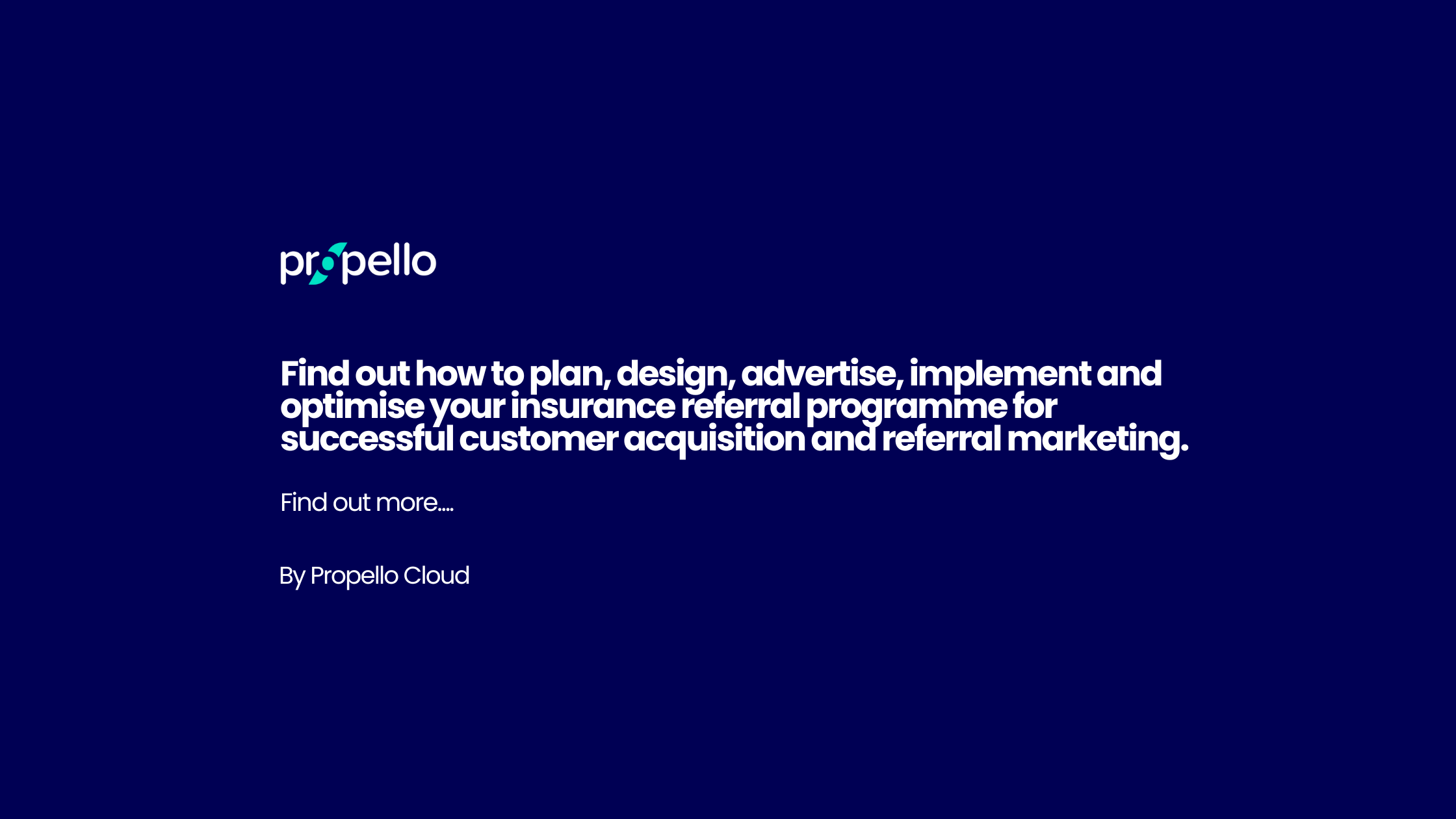Key takeaways
| Referral programmes work because they’re based on trusted recommendations between people—not traditional advertising. | |
|
|
Compared to paid marketing, referrals offer a more cost-effective way to acquire high-intent customers. |
|
|
Understanding your customer preferences helps you tailor rewards, messaging, and sharing mechanisms for higher participation. |
|
|
Referral rewards in insurance are often regulated. Always check your market’s legal guidelines before launching. |
|
|
Ask for referrals at key moments of satisfaction, and make the process as simple and frictionless as possible. |
|
|
Continuously refine your referral strategy using data, A/B testing, and customer feedback. |
|
|
Offer extra incentives to top referrers and consider rewarding actions beyond policy sales to scale advocacy. |
What are the Benefits of Insurance Referral Programmes?
Referral programmes consistently demonstrate an increase in lead generation. In addition to this, they also improve the quality of your leads. All this comes down to tapping into the trust between people. As a result, marketing costs are lowered, conversion rates improve, and customer loyalty deepens.
Lowers Customer Acquisition CostsTraditional marketing is expensive. Even to be heard costs a lot. In the insurance industry, where customers are constantly shopping around and lured in with lower sign-up costs, they can become despondent to the same old. |
Higher Conversion RatesTrust between friends and family often accelerates decisions. Leads that come through referrals convert far more reliably because they come pre-qualified by someone the prospect knows. |
Enhanced Customer Loyalty and RetentionReferrers have also been shown to stick around for longer. Insurance companies prospering from heaps of advocacy have obviously put a lot of effort into satisfying their customer base. Satisfied customers are retained customers. |
Increased Brand Awareness and TrustEvery referral plants your name in a new conversation. Unlike ads, which people are naturally inclined to tune out, personal endorsements carry weight. They simultaneously expand your brand’s reach and reinforce trust towards your brand. |
How Do You Design an Effective Insurance Referral Programme?
A strong referral programme starts with smart planning. You can design an effective referral programme by setting clear objectives and goals, identifying your target audience, choosing the best rewards for your audience, and the most suitably programme structure. Done right, your programme will become a natural extension of the trust you’ve already built with customers.
Define Clear Objectives and Goals |
Clear goals shape smart design. If your aim is to acquire more customers, increase revenue, or enter new markets, remember to use SMART goals. |
Identify Your Target Audience |
Since referrals tend to come from the happiest customers, metrics like NPS can help pinpoint your strongest promoters. Customers that you score a high NPS with are most likely to share their positive experiences with new leads. Once you identify these individuals, incentivise them to make a referral. |
Define Referral Incentives and Rewards |
It’s one thing to calculate the cost of a reward—it’s another to choose one your policyholders actually care about. While gift cards and policy discounts are popular, the most effective incentives are tailored. |
Determine the Programme Structure |
There’s quite a substantial amount of research that companies usually have to undertake to choose a structure that supports their strategy. You need to consider whether rewards be immediate or delayed? One-time or tiered? One-sided or shared? The right format balances simplicity for users with alignment to your business goals and customer behaviours.
|
What Are the Best Practices for Running an Insurance Referral Programme?
The success of your referral programme will come down to its execution. The tech you choose, the tone of your follow-ups, even the tiniest of details will make a huge difference. So to make your programme easy to join, rewarding to use, and built to last, here’s some best best practices to follow.
Use Referral Software to Track, Manage, and AutomateManual tracking is cumbersome and prone to mistakes. At Propello, we recommend Investing in referral software, tailored specifically for the insurance sector. This could be part of a loyalty platform like Propello’s. |
Make Your Programme Easy to Use and UnderstandClarity always beats cleverness as recent studies have shown. For your referral programme to be successful your customers must be able to use it. If they don’t know how to join it or make referrals they won’t bother. |
Ask for Referrals at the Right TimesIt’s often said that referrals are the ultimate expression of loyalty. For insurers, who traditionally relied on acquisition-led models, higher retention may be perceived as an automatic opportunity for referrals. Ripe for the taking. However, in brand advocacy, timing matters. |
How Do You Establish and Promote Your Insurance Referral Programme?
A great referral programme needs more than just excellent design. It needs visibility and that comes down to effective promotion. That means making it easy to find, simple to share, and compelling enough to act on. So let’s look at some actionable steps you can take today to make your referral programme shine across all of your channels and turn awareness into engagement.
Promote Your Referral Programme on Marketing ChannelsVisibility starts with integration. Every channel your company has, from your website, social media channels to landing pages and emails, should feature your referral programme. Your customers should see references to your referral programme across all touchpoints. The more naturally it shows up in the customer journey, the more likely people are to notice and act. |
Encourage Employees to Promote the ProgrammeYour team is perhaps your strongest asset. Therefore, train staff to mention the programme during conversations with policyholders, especially at high-trust moments. When employees advocate for the referral offer, it feels personal and participation tends to follow. |
Use Social Proof to Encourage ParticipationHighlight testimonials, success stories, and real rewards earned through the programme. Seeing that others have benefited builds credibility and encourages hesitant customers to join in. |
Craft Compelling Referral MessagingFocus on what’s in it for both the referrer and the referred. Your messaging should be clear, concise, and always contain benefit-led language. Highlight the ease of sharing unique referral links (or the referral process), the value of your service, and the mutual reward. A good referral should feel like a win-win. |
How Do You Monitor and Optimise Your Insurance Referral Programme?
Monitoring and optimising your insurance referral programme will be a continuous cycle of measurement, analysis, and refinement. To keep performance high and engagement strong, see your referral strategies as dynamic, evolving systems that constantly shift.
-
Start with referral tracking every referral journey from share to sign-up, ensuring accurate reward distribution and identifying any friction in the process.
-
Review key metrics like referral volume, conversion rate, and customer acquisition cost. Compare them with other marketing channels to understand your ROI.
-
Train agents and internal teams on how the programme works. Clarity drives confidence and compliance.
-
Most importantly, be ready to adjust based on data and customer feedback. A/B testing rewards, experimenting with messaging, or shifting timing can all make a meaningful difference over time.
For a more detailed breakdown of the metrics and methods that matter, read ‘Measuring and Optimising Referral Programme Success’ section in this article.
How Do You Ensure Long-Term Success of Your Insurance Referral Programme?
To sustain results in their referral programmes, insurers should think beyond short-term wins and build momentum with continued relevance. This means evolving the customer experience, maintaining engagement, and recognising top contributors. With the right structure and strategy, long-term growth becomes both achievable and scalable.
|
|
|
Referral Programmes Succeed Because Trust Still Matters Most
Insurance referral programmes are the go-to strategy for sustainable, cost-effective growth. With much of the insurance industry switching from acquisition to retention-based models, the time of consumer trust is no longer on the horizon. It’s here.
Modern insurance customers expect the same level of rewarding experiences they see across other sectors. A referral programme is a great addition to your loyalty initiatives. A natural endpoint of all your endeavours in rewarding loyalty, in support of a retention-based model.
Built on trust, these programmes reduce customer acquisition costs, boost conversion rates, and strengthen long-term loyalty. When supported by strong service, the right tools, and clear communication, referral programmes can become a key differentiator in today’s competitive insurance landscape. To learn more on how to support a referral programme check out our guide on Referral Marketing.
FAQS
What is an insurance referral programme?
An insurance referral programme rewards existing customers when they refer friends or family to your company. It creates win-win incentives that boost loyalty, generate new leads, and reduce acquisition costs for insurers.
Why are referral programmes effective in insurance?
They’re built on trust—a key factor in insurance. Personal recommendations lower risk exposure for new customers and improve lead quality, increasing profitability and retention.
How do referral programmes lower acquisition costs?
By replacing costly ad spend with peer-driven recommendations, referral programmes reduce customer acquisition costs while improving lead conversion across lines of business.
What are the best incentives for insurance referrals?
Insurance policy discounts, cash rewards, or other familiar rewards like Amazon gift cards work well. Incentives should align with customer needs and your risk exposure tolerance while supporting long-term profitability.
When should insurers ask for referrals?
Ask after positive experiences—like claims approval or renewals—when customer satisfaction is high. Timing impacts engagement and overall programme performance.
Do insurance referral programmes need to be compliant?
Yes. Regulatory restrictions vary by region. Incentive limits, licensing, and disclosure rules all apply. Legal review is vital before launch to avoid challenges.
What referral metrics should insurers track?
Track referral volume, conversion rate, customer acquisition cost, and customer lifetime value. These metrics measure programme success and impact across distribution channels.
How can insurers keep referral programmes fresh?
Rotate incentives, run seasonal campaigns, and spotlight top referrers. These tactics keep your programme engaging and adaptable to shifting customer expectations and emerging risks.
Can referrals impact long-term loyalty?
Yes. Referred customers tend to stay longer and are more profitable. Plus, active referrers often show stronger brand allegiance, boosting overall retention and outlook.
What tools help manage insurance referral programmes?
Use referral software integrated with CRM systems to automate tracking, manage rewards, and monitor real-time performance. It ensures smooth operations and data-driven optimisation.
Mark Camp | CEO & Founder at PropelloCloud.com | LinkedIn
Mark is the Founder and CEO of Propello Cloud, an innovative SaaS platform for loyalty and customer engagement. With over 20 years of marketing experience, he is passionate about helping brands boost retention and acquisition with scalable loyalty solutions.
Mark is an expert in loyalty and engagement strategy, having worked with major enterprise clients across industries to drive growth through rewards programmes. He leads Propello Cloud's mission to deliver versatile platforms that help organisations attract, engage and retain customers.





.png)